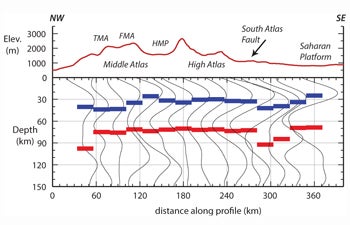Floating Mountains
The Atlas Mountains defy the standard model for mountain structure in which high topography must have deep roots for support, according to a new study from earth scientists at USC Dornsife.
In a new model, the researchers show that the mountains are floating on a layer of superhot rock that flows beneath the region’s lithosphere, perhaps all the way from the volcanic Canary Islands, just offshore northwestern Africa.
“Our findings confirm that mountain structures and their formation are far more complex than previously believed,” said lead author Meghan Miller, assistant professor of earth sciences.
The study, coauthored by Thorsten Becker, professor of earth sciences, was published by Geology on Jan. 1, 2014 and highlighted by Nature Geoscience.
A well-established model for the Earth’s lithosphere suggests that the height of the Earth’s crust must be supported by a commensurate depth, similar to how a tall iceberg doesn’t simply float on the surface of the water but instead rests on a large submerged mass of ice. This property is known as “isostasy.”

Profile depicting the height and depth of the Atlas Mountains. The blue bars indicate the boundary between the crust and the superhot rock below, about 15 km shallower than predicted by previous models.
“The Atlas Mountains are at present out of balance, likely due to a confluence of existing lithospheric strength anomalies and deep mantle dynamics,” Becker said.
Miller and Becker used seismometers to measure the thickness of the lithosphere — the Earth’s rigid outermost layer — beneath the Altas Mountains in Morocco. By analyzing 67 distant seismic events with 15 seismometers, their team was able to use the Earth’s vibrations to “see” into the deep subsurface.
The Atlas Mountains reach a height of greater than 13,000 feet, but they reach a depth of only around 25 miles. The current traditional models of the Earth’s lithosphere indicate that the depth of the mountains should extend down about 9 miles further.
“This study shows that deformation can be observed through the entire lithosphere and contributes to mountain building even far away from plate boundaries,” Miller said.
Miller’s laboratory is currently conducting further research into the timing and effects of the mountain building on other geological processes.
This research was funded by the National Science Foundation, grant EAR-0809023.